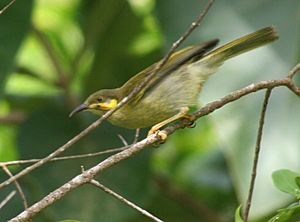Polynesian wattled honeyeater facts for kids
Quick facts for kids Polynesian wattled honeyeater |
|
|---|---|
 |
|
| Conservation status | |
| Scientific classification | |
| Genus: |
Foulehaio
|
| Species: |
carunculatus
|
The Polynesian wattled honeyeater (Foulehaio carunculatus) is a special type of bird. It belongs to the honeyeater family, Meliphagidae. This bird was once thought to be the same species as the Fiji wattled honeyeater and the kikau.
This bird is only found on islands in the Central Pacific. You can see it in places like American Samoa, Fiji, Samoa, Tonga, and Wallis and Futuna Islands.
It lives in different kinds of habitats. These include warm, wet forests in low areas. It also lives in tropical mangrove forests near the coast. Sometimes, you can find it in wet forests on mountains too.
About the Polynesian Wattled Honeyeater
The Polynesian wattled honeyeater is known for its unique look. It has small, fleshy growths called "wattles" on its face. These wattles are usually bright and stand out.
This bird plays an important role in its island homes. It helps to pollinate plants as it feeds on nectar. It also helps to spread seeds by eating fruits.
How the Bird Got Its Name
The Polynesian wattled honeyeater was first officially named in 1788. A German scientist named Johann Friedrich Gmelin described it. He gave it the scientific name Certhia carunculata. The word carunculata comes from Latin. It means "a small piece of flesh," which refers to the wattles on the bird's face.
Later, in 1852, another German scientist, Ludwig Reichenbach, placed this bird in a new group. This group is called the genus Foulehaio. Today, the Polynesian wattled honeyeater is one of three honeyeaters in this group.
Different Kinds of Honeyeaters
For a long time, scientists thought the Polynesian wattled honeyeater was the same as two other birds. These were the Fiji wattled honeyeater (Foulehaio taviunensis) and the kikau (Foulehaio procerior).
However, in 2014, new studies looked at the birds' DNA. These studies showed that they were actually different species. So, now they are recognized as three separate types of honeyeaters. The Polynesian wattled honeyeater is considered "monotypic." This means there are no different types or subspecies of it.


